Eid Church
Nordfjordeid is considered the oldest church site in Nordfjord after Selja. This is the location of the first parish church in Nordfjord. There have been a total of four or five churches here over the centuries. The current church has been standing for more than 150 years and is known as the rose-painted church in Nordfjord.
In 1915, painter and woodcarver Lars T. Kinsarvik was given responsibility for major restoration work and transformed its interior into a rare and magnificent space with a strong national romantic character.
Ervik Church
The church, which was formerly Ervik Chapel, is a rectangular church from 1970.
The church was erected to commemorate the sinking of the Hurtigruten ship SS Sanct Svithun during the Second World War, in which 50 people lost their lives. The villagers contributed greatly to rescuing 78 survivors. Inside the church, there are several items from the ship, including the ship’s clock, while the anchor is located outside the church.
Ervik became a parish church in 1997.
The cemetery in Ervika dates back to at least 1550 and it was probably the casualties of shipwrecks that were first buried here. The sea around the Stad peninsula is considered by many to be the largest underwater cemetery on the Norwegian coast. Legend has it that Portuguese sailors were the first to be buried in Ervika. The cemetery was located here due to the great distance to the parish church in Selje.
Heggjabygda Church
In 1913, Heggjabygda’s minister Anton Johnson proposed that the village should have its own cemetery, so that funeral processions would no longer need to travel by boat across the water to Hornindal, the site of Heggjabygda’s parish church at the time. Two years later, the same minister made a recommendation that a chapel be built on the site. The municipal authorities in Hornindal needed to provide guarantees for the construction of the building, as well as its maintenance and operating costs.
When construction started in 1934, the villagers themselves were responsible for procuring stone for the walls and materials for the building itself.
It was a big day in the village when the church was finally consecrated in October 1936.
Kjølsdalen Church
A lack of space for graves was the impetus for realising a new church building in Kjølsdalen. The cemetery was taken into use in 1928, bringing an end to the arduous journeys to the cemetery in Davik on the other side of the fjord.
A few months after the outbreak of the Second World War in 1940, the people on the north side of the fjord, in what was then Davik parish, had their popular demand for their own church realised. They were finally able to avoid the journey across the Nordfjord to attend church. Kjølsdalen was the only church in the county to be consecrated during the war. By then, it had been 64 years since the request for a church was first brought.
In 1954, Kjølsdalen and the north side were separated as a separate parish in Davik. In 1965, the church was transferred to Eid parish in connection with the municipal regulation.
Leikanger Church
The current church building at Leikanger stands on its third site, but in a very different form from the first church that was erected in Bø in Selja at the end of the 1500s. From 1654 to 1866 the church stood in Selje, before being moved to its present location. It has since been extensively refurbished and has as many as three altarpieces, one from each of the places where the church has been placed.
The old church from Selje was demolished shortly after the last service was held on April 22, 1866, and all the wood was loaded onto a square-rigged sail vessel known as a jekt sail and transported around Stad. Six months later, the church was again ready for use. No other church in the county has been moved as many times as Leikanger Church. Since it was not new, the Ministry of Church Affairs decided that a new consecration ceremony for the church was not necessary, but that a suitable holiday should instead be held in connection with the consecration of a new cemetery.
Leikanger has been the local parish church since 1997.
Selje Church
Selje Church is located north of Seljesanden in Selje. The church, which seats 500, was consecrated on May 13, 1866 and is the main church in Selje parish.
One of the first churches in Norway was completed in Selje after Olav Tryggvason made it a holy site in the year 996. According to legend, it was the minister’s wife, Maren Søffrensdatter, who arranged for the church to be located by the shore north of Seljesanden.
When the church at Bø was torn down, the timber was floated across the sound to Nabbetangen, near the vicarage. The intention was that the church should be set up at Hagevollen, not far from the vicarage. Mrs. Maren didn’t like the idea of having the spirits of the dead come so close to the houses. At night, she told the servant boy to loosen the moorings on the timber raft. A southerly wind blew, and the raft sped off across the cove and over to the shore on the north side of the Prestesanden. When people woke up and saw what had happened, they interpreted it as a sign that the church had to be built here, and that is precisely what was done.

Stårheim Church
At the old chieftain’s seat of Stofreimr, a private chapel was likely erected in the early 1100s. The church history of the village contains both fires and drama, with the power elite on one side and angry farmers on the other.
Today’s Stårheim Church is considered the third in its line, built at a time when white, lofty places of worship were appearing throughout the county and the rest of the country. The church at Stårheim has the same foundation as the previous church, which was located just beside the road alongside the fjord. From the outside, it looks like most rectangular churches, but its interior contains several unique features, as it was designed by a creative and skilled architect.
The vestries on either side of the choir have doors at opposite ends of the hallway that was built along the east wall. There are also doors leading from this hallway to the chancel itself.
Totland Church
Completed in 1912, Totland Church, formerly Totland Chapel, seats 250 and is located in Totland by Bryggja.
Up until 1953, this place of worship had the status of a chapel in Rugsund parish. That year, Totland was made a separate parish within Davik parish. In 1967, Totland parish was transferred from Davik to Vågsøy parish. Totland parish ceased again in 2002, when the parishes in Vågsøy were merged into one common parish called Vågsøy parish. It’s today called Totland parish.
Prior to the completion of the church in Totland, parishioners on the north side of the Nordfjord in Davik parish belonged to Rugsund Church.









